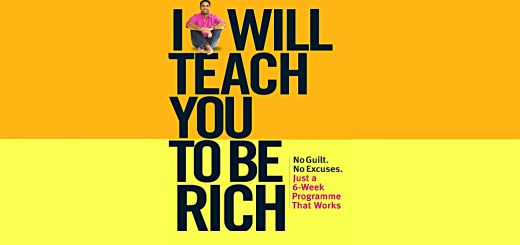I Will Teach You To Be Rich 5 – Maintenance and Life Events

Today’s post is our fifth visit to the popular I Will Teach You To Be Rich by Ramit Sethi.
Contents
Maintenance
Chapter 8 of Ramit’s book is about maintenance.
He starts with the obvious point that the more that you put into your “investing system”, the more you will get out of it in the end.
- He invites his readers to squeeze their Conscious Spending Plans (budgets) in order to have a bit more money left over to invest.
He recommends (like we do) that you ignore day-to-day market commentary and Cut Out The Noise.
You should also forget about the returns of the recent past (what happened last year).
- It’s what will happen over the next 20 years that matters.
And you should forget about property investing:
Renting is actually an excellent decision in certain markets – and real estate is generally a poor financial investment.
Here in the UK, your first property has tax advantages.
- Owning a property as you hit retirement also reduces your sequencing risk.
So I am in favour of owning the house you live in,.
- But no further property is required, and buying more comes with its own problems (maintenance, tenants, gearing etc).
Rebalancing
You’ll need to rebalance every twelve to eighteen months. Otherwise, within a couple of years, your allocation will be completely skewed.
Rebalancing is nothing more than selling things that have gone up to buy more of what has gone down.
- Too much of your portfolio will be allocated to the winners and not enough to the losers.
If you are still adding money to your portfolio every month, then there is no need to sell anything.
- Simply buy just those assets to which you are underweight.
This saves on transaction fees, and possibly on taxes (if your affairs are imperfectly organised).
Unfortunately, rebalancing can’t be automated, other than:
- buying a single fund which does this automatically (for small portfolios only)
- using a robo-advisor (too expensive)
One thing to remember about rebalancing is that you only need to rebalance at the highest level – your entire net worth.
- You don’t need each individual investment account to match to your target allocation.
I combine mine and my partner’s portfolios into one big pot and rebalance that.
- Some of the individual accounts are way off beam, and often contain just a single type of asset.
Taxes
Ramit is not a big fan of tax planning.
If you’re paying 30 percent in taxes on something, it means you made 70 percent elsewhere, so do not freak out. It’s your civic duty.
I respectfully disagree.
- It’s my right to arrange my affairs in as tax-efficient a manner as I please.
In practice, in the UK, there’s not much planning involved:
- buy a house to live in
- fill up your SIPP
- fill up your ISA each year
- when your SIPP is full, think about buying VCTs and EIS funds each year.
As it happens, Ramit is fine about using tax-sheltered accounts.
You can also use up your capital gains allowance of £12.3K and your dividend allowance of £2K pa.
- This means that a theoretically taxable account of somewhere between £50K and £100K should attract no tax.
That’s all there is to it.
- No offshore, Panama Papers-type shenanigans are required.
When to sell
There are only three reasons [for young people] to sell [their] investments: You need the money for an emergency, you made a terrible investment and it’s consistently underperforming the market, or you’ve achieved your specific goal for investing.
With Ramit’s tracker fund solution, rebalancing should handle underperformance, which leaves us with two.
- Assuming financial independence/retirement as the goal, selling when you get there (to fund living costs each year) is a no-brainer.
So we’ll focus on emergencies.
- To begin with, you should have an emergency fund of six months of expenses (more in retirement or during a pandemic).
After that, Ramit suggests selling valuables, but that might take longer than you have.
- I guess a credit card might bridge the gap (Ramit has that option lower down the list).
After that, Ramit says to ask your family.
- I suppose that would work for some people – I’m the one who is sensible with money in my family.
I think you should just make sure that your emergency fund is big enough.
- And whatever happens, you shouldn’t need to sell your investments to deal with it.
Life events
Chapter 9 is about the finances of life events – things like weddings, cars and houses.
- But we begin with student loans.
Student loans
I’m too old to have a student loan, so this is all theoretical to me.
Here in the UK, student loans operate as a graduate tax above a minimum earnings level.
- There is a nominal loan balance, but most people don’t earn enough during the 30-year payback period to clear the loan.
Which means that loan overpayments don’t make sense for most people.
- There are calculators online to help you make your personal decision.
Ramit points out that most student loans are worth the expense.
- Graduates in all but the most esoteric of disciplines significantly out-earn their non-graduate peers.
He also notes that if the interest rate on the loan were to rise to way beyond what you might earn from investments, you might want to think about overpayments.
Ramit thinks that for most people, a 50/50 split between overpayments and investing your spare cash will work out best.
- This is essentially hedging your bets on interest rates and investment returns over a long and uncertain future – which is fine.
But if I had a loan, I would check out all the online calculators to be sure.
Parents
Ramit thinks that it’s daft to let your parents manage your money.
- He is Indian, so this may be cultural.
It was never on offer for me – my family knew (and knows) nothing about money.
Persuading your parents to (belatedly) adopt the principles from his book is, on the other hand, A Good Thing.
Partners
It’s really helpful if you are on the same page financially as your long-term partner.
- One spender and one saver is not a match made in heaven.
Even if you start from different viewpoints, you are going to have to reach some agreement on what is worth spending money on, and what is worth saving for.
- What is the end game in terms of lifestyle, and when would you like to get there?
If you can’t agree on some things, then setting fixed budgets (allowances) for items that only one of you wants can help.
The process is similar to what Ramit describes in the rest of the book, only this time it’s a joint plan for the pair of you.
- Note that this doesn’t mean joint accounts – you can have completely separate finances (until you are married) and still be working towards a joint plan.
One of the big items to decide is when to retire.
- You might think that it’s obvious that you would quit as soon as you become financially independent.
But some people hate their jobs and others love their work.
I retired nine years ago by my partner is still going strong.
- That’s almost 50% of our relationship where I’ve spent the working week sitting at home alone, which is definitely not the retirement that I expected.
Another is how to divide expenses when one of you earns more than the other.
In long-term relationships, the simplest approach is just to split your income equally.
- But it’s hard to start a new relationship from this point.
Proportionately to salary is a good place to start.
Weddings
Weddings are expensive, and lots of people will have a separate savings goal to fund them.
When Ramit wrote the UK edition of his book, he claimed that the average cost was £20K.
- As I write, it’s £16K for the wedding, or £21K if the ring and honeymoon are included.
I’ve been married, and the wedding wasn’t cheap, but the father of the bride paid for almost everything.
- Maybe that isn’t a thing anymore.
Saving the wedding money is no different than saving money for retirement.
- Except that you have a lot less time to hit your target.
The average age at marriage is about thirty-two for men and thirty for women.
So at age 25 you need to save around £3K per year.
Work
Ramit makes the point that increasing your earnings is as useful as living more frugally.
- Both ways you end up with more to invest at the end of the month.
Ramit’s a big fan of negotiating, and salary rises are no exception.
- But my experience in the UK is that you have to change employers to get big increases.
Ramit recommends negotiating when you first join a firm.
- This is when you have the most leverage.
And always have another offer to play off against the main one.
- If you do get the rise, make sure not to waste it on lifestyle inflation.
Cars
It will come as no surprise that Ramit thinks that you should negotiate the prices of big-ticket items.
With cars, he points out that the length of time that you keep it is the most important factor in whether it’s a good deal.
- I think that not buying a brand new car is a pretty important point, too.
And never finance a depreciating asset – buy in cash.
Houses
Ramit is not a property fanatic.
- He thinks that in general, they are not a great investment (I agree).
I’m not saying buying a house is always a bad decision. It’s just that you should think of it as a purchase, rather than as an investment.
Ramit thinks that renting is a viable alternative to buying a property.
- In terms of raw numbers that is sometimes the case, but your first property has tax advantages (no CGT) and protects against sequencing risk at retirement.
So I would always be looking to buy.
If you do rent, make sure that you invest a sum equivalent to the hidden costs of ownership (maintenance, buildings insurance etc).
- Don’t waste this money on lifestyle.
We live in unusual times – house prices are very high in the UK, but interest rates (and therefore mortgage payments) are very low.
- So the real obstacles to buying the home of your dreams will be saving the deposit and persuading the lender that you are a good bet for repaying the loan.
Staying put is a big deal with houses, too, especially when you take into account transaction charges (stamp duty, estate agents and legal fees).
- I’ve had five cars and two houses over the last 34 years.
And that’s it – we’ve finished the book.
- It’s very much an entry-level work, for young people who don’t know much about money.
Most of it is correct, though I’m keener than Ramit on tax-planning and less keen on negotiating.
- We also disagree on things like passive only, lifestyling, very few funds etc.
But my main criticism is that it takes so long to get it points across.
- The book could have been just as useful at a quarter of the length.
I’ll be back in a few weeks with a summary of all five articles that I’ve written about the book.
- Until next time.














